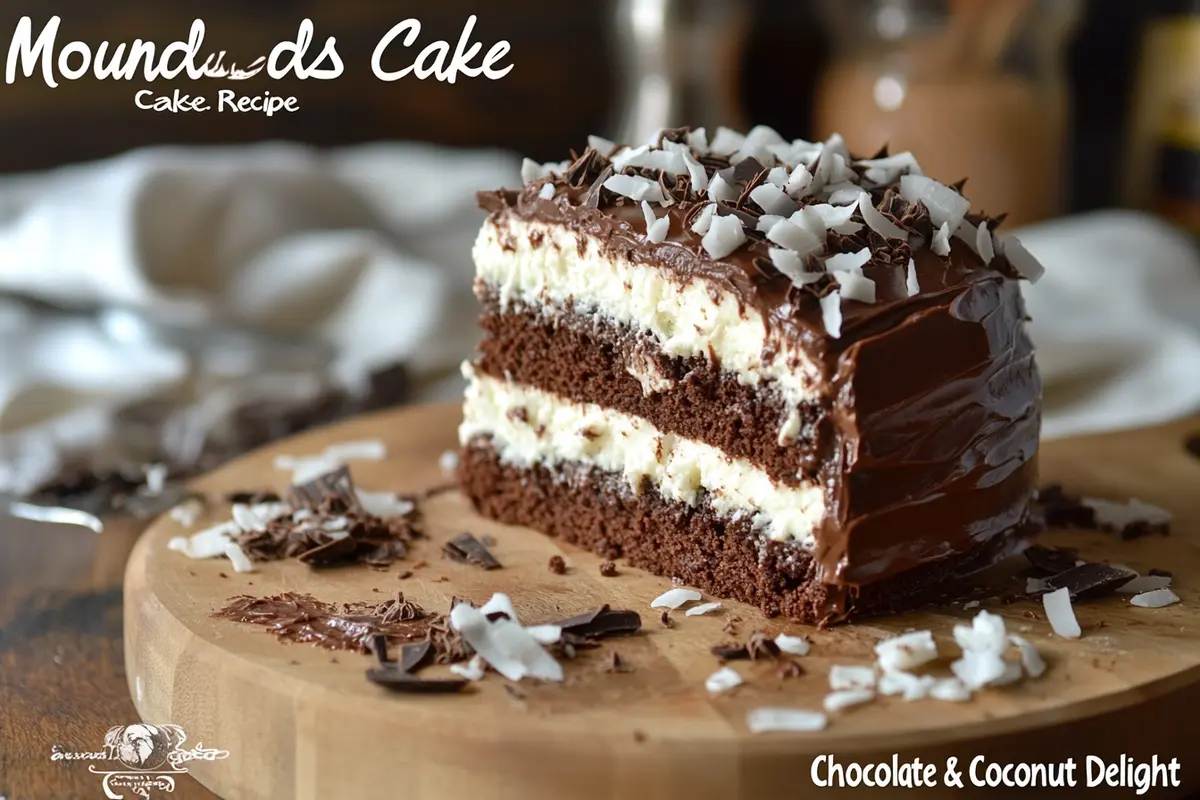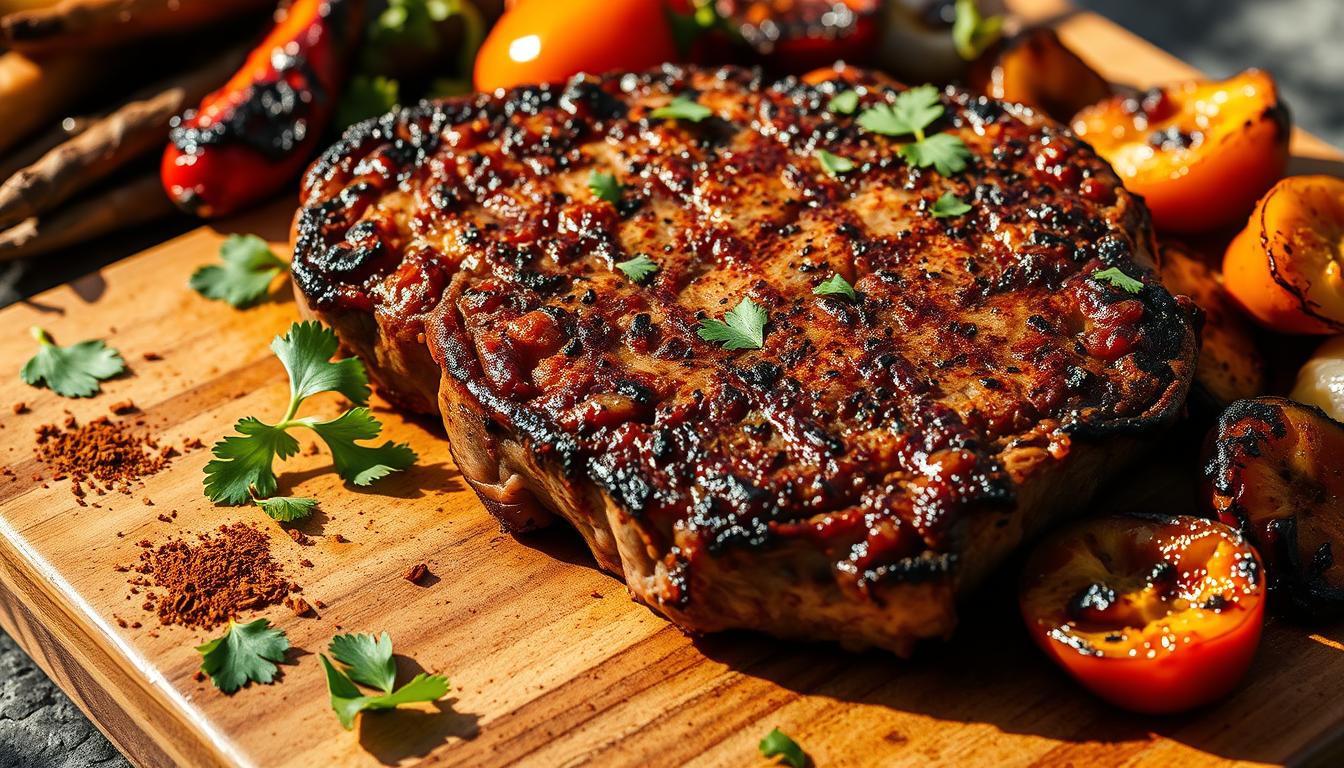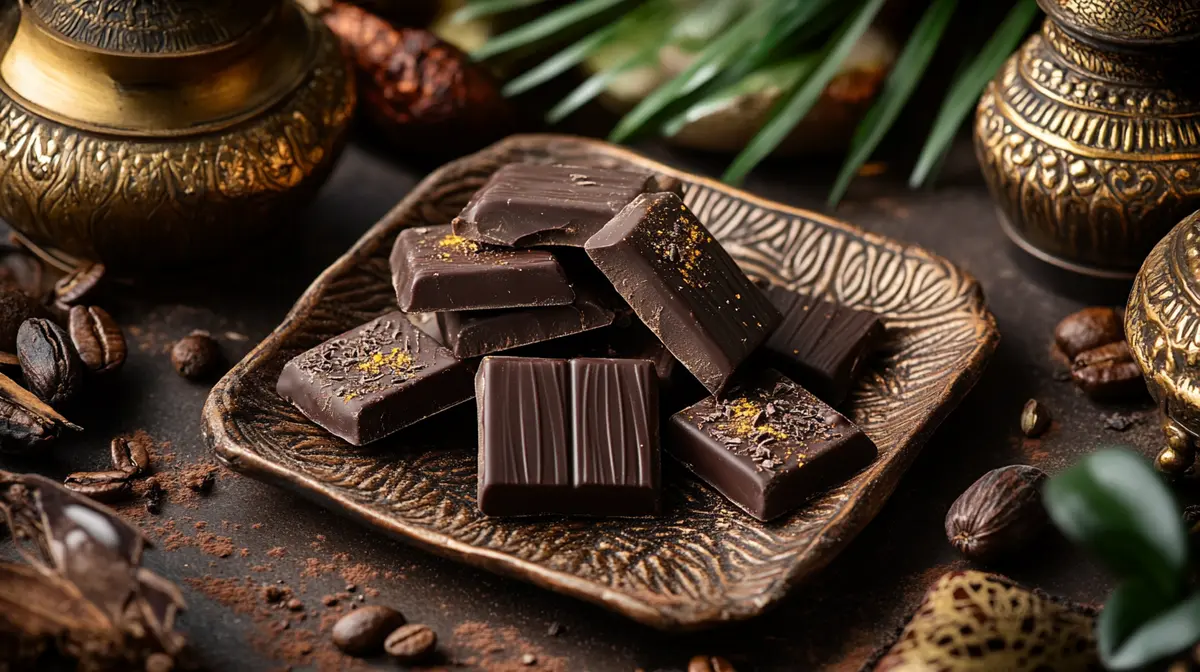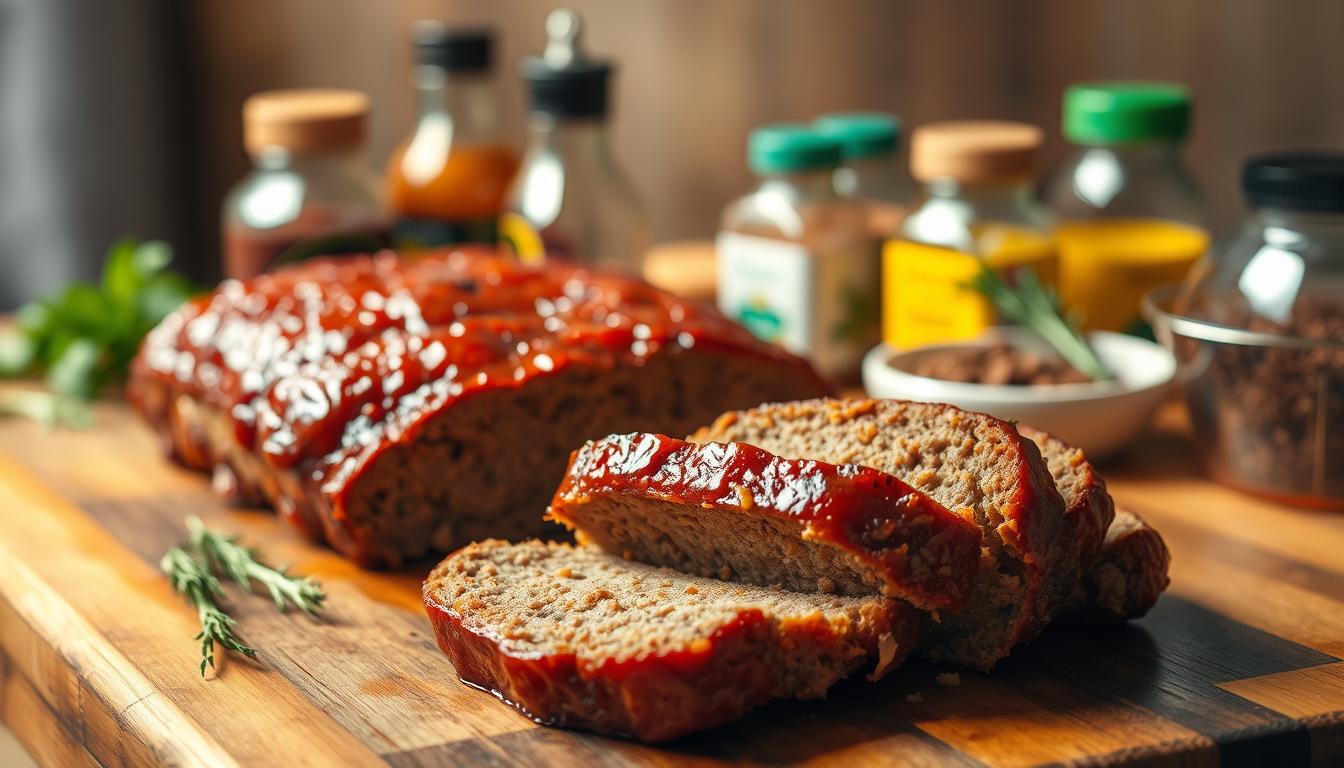Are you looking for a dessert that combines deep chocolate flavor with a generous helping of sweet coconut? If so, you’ve arrived at the perfect spot. In this conversational guide, we’ll explore everything there is to know about creating a mounds cake recipe from scratch, how to adapt it to different tastes, and how to avoid common pitfalls. You’ll discover helpful tips, ingredient insights, and frosting ideas that will make your cake stand out from the crowd. Best of all, this discussion offers an approachable style, as though we were chatting in your kitchen while whipping up this delicious treat.
Whether you’re a baking enthusiast or just starting out, the Chocolate mounds cake recipe is a simple yet decadent confection that marries moist chocolate cake layers with a coconut filling reminiscent of the classic candy bar. Read on for more than enough detail to prepare this dessert with confidence—and a bit of extra flair.
1. Understanding the Appeal of the Mounds Cake Recipe
Chocolate and coconut are two ingredients that were practically destined to be together. The sweet, tropical nuttiness of coconut pairs beautifully with rich, velvety chocolate. When you fuse these flavors into a layered cake, you get a dessert that impresses both in taste and appearance. But why exactly is this combination so beloved, and what makes the mounds cake recipe stand out among all the other chocolate-and-coconut desserts on the market?
- Nostalgic Candy Bar Flavor: The Mounds candy bar has captured the hearts of coconut lovers for decades. The bar’s dense coconut filling and smooth chocolate coating have made it a staple for anyone who prefers a coconut-centric experience. Transforming that iconic flavor profile into a lavish cake creates a sense of nostalgia with every bite.
- Contrasting Textures: The pleasing contrast between the light fluffiness of a chocolate cake layer and the chewiness of coconut is part of what makes each forkful so satisfying. Additionally, coconut’s slightly crisp texture, especially if toasted, lends depth to the overall mouthfeel.
- Bold Colors: A dark chocolate backdrop with flecks or layers of snowy coconut is visually striking. The interplay of brown and white creates a dessert that’s eye-catching whether sliced or served whole.
- Wide Appeal: Most dessert lovers appreciate chocolate cake on some level. Throw coconut into the mix, and you’ll likely attract those who also crave tropical or refreshing flavor notes. It’s a versatile combination that can appear in casual potlucks, birthday parties, or even holiday gatherings.
- Easy Personalization: The basic structure of a mounds cake recipe can be adapted to various dietary needs or flavor preferences. You can switch up frosting types, cake mixes, or even sweetener choices to fit your lifestyle.
In sum, it’s no wonder so many people search for the perfect mounds cake recipe. This cake is rooted in nostalgia, texture contrast, and the timeless union of chocolate and coconut. Throughout the following sections, we’ll dive deeper into how to perfect this enchanting dessert in your own kitchen.
2. The History of Chocolate and Coconut Desserts
Before we jump into the specifics of the mounds cake recipe, it’s intriguing to take a quick look at how chocolate and coconut found each other in the dessert world. Though the Mounds candy bar is a 20th-century invention, pairing coconut with chocolate extends much further back.
- Early Dessert Traditions: Historically, coconut was imported to many regions as a luxury item. Chocolate, on the other hand, has roots in ancient Mesoamerica. When global trade routes expanded, combining coconut and chocolate became more practical. Cakes and candies that featured these ingredients rose to prominence in Europe and North America, as people became hooked on the unexpectedly delightful contrast of flavors.
- Rise of Candy Bars: After major candy makers introduced bars like Mounds and Almond Joy, coconut quickly cemented itself as a popular filling for chocolate candy. These bars ushered in a wave of homemade “copycat” recipes, as well as cakes and pies featuring the same winning combination.
- Transition to Cakes: Home cooks soon discovered how effortlessly coconut can be incorporated into cake batter, toppings, and fillings. The candies served as the initial inspiration, but variations multiplied. Over time, a distinct mounds cake recipe emerged, paying homage to that classic bar while enabling bakers to explore different presentations.
- Culinary Evolution: Today, coconut is used in countless pastries, from macaroons to cream pies. Still, the synergy of coconut and chocolate in cake form remains one of the most popular dessert themes. Each new generation of bakers continues to refine techniques, experiment with flavor boosters, and develop new ways to frost or garnish these mouthwatering desserts.
Keeping this background in mind, let’s dive headfirst into the fun part: the essential elements of a mounds cake recipe and how to adapt it to your preferences.
3. Key Ingredients You’ll Need
To craft a delectable mounds cake recipe, you’ll want to gather some fundamental ingredients. Here’s a rundown of the must-haves, along with possible substitutions to accommodate dietary restrictions or creative spins:
- Flour: All-purpose flour typically provides the best balance of structure and softness. Feel free to use cake flour if you prefer a lighter crumb, or gluten-free flour blends if necessary.
- Cocoa Powder: Opt for a high-quality, unsweetened cocoa powder. Dutch-processed cocoa can yield a richer, darker color, whereas natural cocoa provides a slightly tangier taste. Your choice can change the overall flavor, so experiment to find what you like best.
- Sugar: Granulated white sugar is the usual go-to, but you can try coconut sugar or a sugar substitute like monk fruit if you aim to reduce refined sugar.
- Butter or Oil: Many traditional chocolate cake recipes rely on butter for flavor and tenderness. Some people, however, prefer oil for increased moisture. If you want a fluffier, more delicate crumb, butter is perfect. If you’re seeking a moist texture, oil is ideal.
- Eggs: Eggs bind your batter and contribute to its rise. Replacements, such as flax eggs or applesauce, can work if you follow a vegan diet or have an egg allergy. You may need to experiment with additional leavening for a consistent texture.
- Coconut: The star of the show is, of course, coconut. You can choose sweetened flaked coconut or unsweetened shredded coconut, depending on how sweet you want your cake to be. Bold coconut flavor can also be achieved by using coconut extract or coconut milk.
- Chocolate Filling or Frosting: A typical mounds cake recipe might call for melted chocolate, sweetened condensed milk, or a ganache-based frosting. Decide whether you want a lighter whipped cream topping or a thicker, fudgy layer that replicates the candy bar experience.
- Leavening Agents: Baking powder and baking soda each play important roles in making your cake rise. Pay close attention to the recipe amounts and shelf life of your baking powder/soda, as expired leaveners can result in flat or dense layers.
- Dairy or Dairy Alternatives: Regular milk, buttermilk, or yogurt can add moisture and tenderness. If you’re lactose-intolerant or following a plant-based diet, choose almond, soy, or coconut milk.
These key ingredients serve as the backbone for your mounds cake recipe. You can adapt them as you wish, but keep in mind the effects each substitution has on flavor, texture, and sweetness. Next, let’s talk about how to prepare your kitchen and gather the proper tools before you begin.
4. Setting Up Your Kitchen for Success
Baking success isn’t only about ingredients. Having the right environment and tools also matters when tackling any new mounds cake recipe. Consider the following steps to streamline your experience:
- Clean and Tidy Workspace: Start by clearing off your countertops and assembling all the tools you’ll need. Baking can become messy fast, so having space to move your mixing bowls, measuring cups, and pans around is helpful.
- Preheat the Oven: For most chocolate cakes, 350°F (175°C) is a common baking temperature. Give your oven 10-15 minutes to preheat thoroughly. An oven thermometer can help verify that the dial setting matches the actual temperature.
- Grease and Flour the Pans: To prevent sticking, use a bit of butter or cooking spray on your cake pans, followed by a dusting of cocoa powder or flour. This step makes it easier to release the cake layers once they’re done baking.
- Set Out Cold Ingredients: If your recipe calls for room-temperature butter, eggs, or milk, take them out of the fridge about 30 minutes before you start. Room-temperature ingredients typically blend more uniformly, resulting in a smoother batter.
- Measure Accurately: Use a digital scale for the utmost precision. If you’re relying on measuring cups, be mindful when scooping flour, sugar, and cocoa to avoid overpacking.
- Line Up Your Toppings: If you plan to decorate with toasted coconut, chocolate ganache, or a special glaze, have those ingredients or tools ready for immediate use once the cake layers are cool.
By setting up your space carefully, you’ll reduce the chance of mistakes or frantic last-minute scrambling. Cooking is supposed to be fun, and a bit of organization goes a long way toward making that possible. Let’s move on to the actual baking process now.
5. Step-by-Step Mounds Cake Recipe Instructions
Below is a general method for creating a mouthwatering mounds cake recipe. Keep in mind that specific measurements can vary from one recipe to another, so adjust to your liking or follow your chosen version meticulously. Nonetheless, the core steps remain relatively consistent.
- Combine the Dry Ingredients
In a bowl, whisk together flour, cocoa powder, baking soda, baking powder, and salt. This ensures that the leavening agents are distributed evenly. - Cream Butter and Sugar (If Using Butter)
In a separate mixing bowl, cream softened butter and sugar until light and fluffy. This step incorporates air and helps yield a softer texture. If you’re using oil instead, whisk the sugar in after combining the oil with eggs or wet ingredients. - Add Eggs and Extract
Add eggs to your butter-sugar mixture one at a time. Beat after each addition to ensure full incorporation. At this stage, you can also add a teaspoon or two of coconut extract for extra coconut aroma. - Incorporate Wet and Dry Mixtures
Alternate adding the flour mixture and the chosen liquid (milk, coconut milk, or buttermilk) to your main bowl. Mix on a low speed to avoid overworking the batter. Stop occasionally to scrape down the sides of your bowl. - Fold in Coconut
Gently fold in shredded or flaked coconut. This is also a good time to add any optional chocolate chips if you want pockets of melted chocolate throughout your cake. Be careful not to overmix, which can make the cake denser. - Divide Batter and Bake
Pour the batter evenly into your prepared cake pans. Smooth the top with a spatula. Place the pans in the preheated oven, and bake until a toothpick inserted in the center comes out clean. This usually takes 25 to 30 minutes, but oven times vary, so keep an eye on your layers. - Cool Completely
Allow the cake layers to cool in their pans for about 10 minutes before gently transferring them to a wire rack. Cool them fully before applying any frosting or glaze. - Prepare the Filling and Frosting
While your layers cool, whip up the frosting of your choice. This could be a coconut buttercream, a chocolate ganache, or a classic cream cheese frosting with coconut essence. If you want an authentic “Mounds” feel, you can even combine sweetened condensed milk and coconut flakes to spread between layers. - Assemble and Decorate
Layer the cake by spreading frosting or coconut filling between each tier. For the top, drizzle melted chocolate or spread a lush ganache. Decorate the sides with toasted coconut flakes for a crispy, golden touch. - Final Presentation
Once you have your glorious mounds cake recipe assembled, feel free to garnish with additional coconut, chocolate shavings, or fresh fruit. Slice it carefully with a sharp knife to reveal the luscious layers inside.
At this point, you’ll have a show-stopping cake that highlights the heavenly combination of chocolate and coconut. Next, let’s explore some flavor twists to keep things interesting for future batches.
6. Flavor Variations to Elevate Your Mounds Cake Recipe
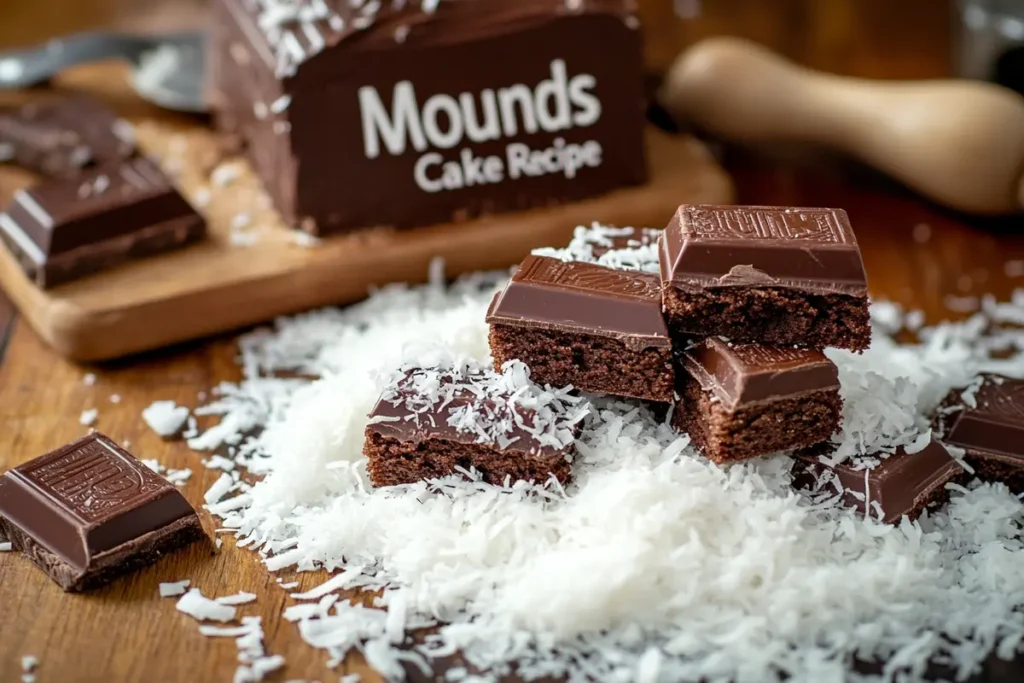
While the traditional mounds cake recipe is undeniably delicious, there are countless ways you can jazz up this already fantastic dessert. Whether you prefer adding subtle hints of caramel or throwing in fruit, these ideas will keep your taste buds guessing:
- Salted Caramel Drizzle
Nothing complements chocolate and coconut quite like a drizzle of salted caramel. Drizzle it over the top layer or swirl some through the batter before baking. This creates pockets of sweet, buttery goodness that balance the deep chocolate flavor. - Tropical Fruit Twist
If you want an even stronger tropical vibe, integrate diced pineapple or banana slices between the layers. The juicy fruit provides extra sweetness, and the acidity of pineapple can complement the richness of coconut. - Almond Crunch
For those who love a hint of nuttiness, sprinkle roasted almonds either on top or between layers. This variation channels the flavor of an Almond Joy bar but in cake form. - Dark Chocolate Ganache
Instead of a standard buttercream, try topping your cake with a luxurious dark chocolate ganache. This approach gives an intense cocoa punch and a smooth, glossy finish reminiscent of a candy bar shell. - Mint-Infused Coconut
If you enjoy a dash of freshness, add a drop or two of peppermint extract to your coconut filling. This will create a cool, invigorating counterbalance to the velvety chocolate base. - Coconut Cream Pudding Layer
Incorporate a layer of homemade coconut pudding or coconut pastry cream between each cake tier. This yields a custardy texture and dials up the tropical factor. If you want a thicker layer, allow the pudding to set before assembling. - Coffee Accents
Adding a teaspoon of instant espresso powder or strongly brewed coffee to the batter can enhance the chocolate notes. You won’t necessarily taste the coffee itself, but it’ll highlight the cocoa’s richness. - White Chocolate Shavings
Garnish the top of your frosted cake with white chocolate curls. The sweetness and creamy texture of white chocolate contrast the darker chocolate cake in a playful way.
Each of these flavor variations can breathe new life into the classic mounds cake recipe. Experiment with them one by one or combine your favorites to develop a signature twist. If you decide to serve your cake at gatherings, guests will appreciate how you’ve thought outside the box while preserving the essence of chocolate and coconut.
7. Frosting, Toppings, and Finishing Touches
No mounds cake recipe is complete without a perfect finishing flourish. Choosing the right frosting or toppings can elevate your dessert from a simple home bake to a masterpiece worthy of social media snapshots. Here are popular options to complete your cake:
- Coconut Buttercream
Beat softened butter or a dairy-free substitute with powdered sugar, a little coconut milk, and coconut extract for a creamy, sweet-tasting spread. Adjust the consistency by adding more sugar or milk until it’s just right for piping or spreading. - Chocolate Ganache
Ganache is both visually appealing and easy to make. Warm heavy cream (or coconut cream) on the stove, then pour it over chopped dark chocolate. Stir until smooth. Let it cool slightly, then pour or spread over your cooled cake layers. The result is a glossy, decadent finish. - Cream Cheese Frosting
If you want a tangy contrast, cream cheese frosting is an excellent choice. Combine softened cream cheese with butter, powdered sugar, and coconut essence. The slight tanginess marries well with the sweetness of the coconut and chocolate. - Sweetened Condensed Milk and Coconut
A simple option is to mix sweetened condensed milk with shredded coconut for the filling layer. This approach mimics the texture of the Mounds candy bar interior. You can top it off with a layer of melted chocolate or chocolate glaze to seal in the coconut mixture. - Toasted Coconut Flakes
Once you’ve settled on a frosting, add toasted coconut flakes to the edges or the top for extra crunch and visual contrast. To toast coconut flakes, spread them on a baking sheet and pop them into a 350°F oven for 5-7 minutes, stirring frequently to avoid burning. - Chocolate Shavings or Chips
Sprinkle chocolate shavings or mini chocolate chips over the frosted cake to amplify the chocolate factor. Alternatively, swirl them into the frosting for mini bursts of cocoa goodness. - Fresh Fruit and Berries
Though not traditional for a mounds cake recipe, fresh strawberries, raspberries, or blackberries can add a bright note of acidity. Place them around the perimeter or in the center for an elegant look that offsets the richness of the coconut-chocolate pairing. - Edible Flowers
For a truly show-stopping finale, garnish the top with edible flowers in complementary colors, such as white orchids or pink blooms. Make sure they’re pesticide-free and suitable for consumption.
Selecting your finishing touches is a matter of personal taste and creativity. A well-chosen topping can highlight your favorite parts of the cake, whether you lean toward extra chocolate, coconut intensity, or a blend of contrasting flavors.
8. Serving Suggestions and Pairings
You’ve crafted a gorgeous mounds cake recipe and perfected the toppings. Now, how should you serve it for maximum enjoyment? Here are a few suggestions that can elevate the experience:
- Warm Slices with Ice Cream
Chocolate and coconut pair incredibly well with a scoop of vanilla, coconut, or even chocolate ice cream. Warm your slice in the microwave for a few seconds, top it with a cold scoop, and watch it melt into the layers. - Coffee or Tea Pairings
The robust flavor of coffee can beautifully complement a slice of mounds cake, especially if you used a darker cocoa powder. Alternatively, a subtle black tea or even green tea can balance the sweetness, allowing each bite of cake to shine. - Coconut Milkshakes
For a coconut overload, serve each slice alongside a creamy coconut milkshake. Add chocolate sauce drizzles inside the glass to match the cake’s profile, creating a dessert-on-dessert extravaganza. - Tropical Fruit Salads
If you want to bring more fresh, tangy notes to your dessert table, pair slices of cake with a fruit salad loaded with mango, pineapple, and kiwi. This approach balances the richness of chocolate and sweetened coconut. - Cocktail Pairings
Make it a party by pairing your mounds cake with cocktails that incorporate coconut rum, coffee liqueur, or chocolate bitters. A piña colada or a simple coconut rum on the rocks might enhance the island feel. - Presentation Tips
Serve each slice on a white or brightly colored dessert plate to make the dark layers of cake stand out. Consider garnishing with a small mint sprig or a drizzle of chocolate sauce. This final flourish is a small detail that leaves a lasting impression.
Whether you keep it simple with coffee or go big with themed pairings, serving your mounds cake recipe in a thoughtful way can deepen the overall tasting experience. Now, let’s talk about how to preserve any leftovers (if there are any!).
9. Storing and Maintaining Freshness
It’s entirely possible you’ll have a couple of slices left after your event, but mounds cake recipe leftovers are usually a welcome surprise. Follow these tips to ensure that your cake remains just as delicious in the days ahead:
- Room Temperature Storage
If your kitchen isn’t too warm, you can keep the cake in an airtight container at room temperature for about 2-3 days. Cover any exposed cut areas with plastic wrap or place a layer of parchment paper directly onto the sliced edges to maintain moisture. - Refrigeration
For longer preservation, particularly if your frosting contains dairy or perishable fillings like custard, place the cake in the fridge. Keep it in a sealed container or wrap it with plastic wrap to avoid absorbing other odors. Expect the cake to remain fresh for up to 4-5 days. - Freezing Slices
If you think you won’t finish the cake soon, freeze individual slices. Wrap each slice in plastic wrap, then place them in a freezer-safe bag. When you’re ready to enjoy a slice, transfer it to the fridge or counter to thaw. A quick warming in the microwave or oven can restore some of the original softness and flavor. - Maintain Toppings
If you used toasted coconut flakes or fresh fruit, you may want to remove or refresh them when storing leftovers. Toasted coconut can become less crisp over time, and fresh fruit can leak juices. In these cases, store fruit separately and add it back on when serving your leftover cake. - Avoid Excessive Humidity
Humidity can compromise the texture of frostings, especially whipped cream or meringue-like toppings. Keep your environment in mind. If you live in a particularly humid climate, refrigeration is usually the better choice.
By following these practices, you’ll be able to prolong the deliciousness of your mounds cake recipe. The next time you crave a midnight snack, you can just open the fridge or freezer and grab a slice without sacrificing flavor or texture.
10. Common Mistakes and How to Avoid Them
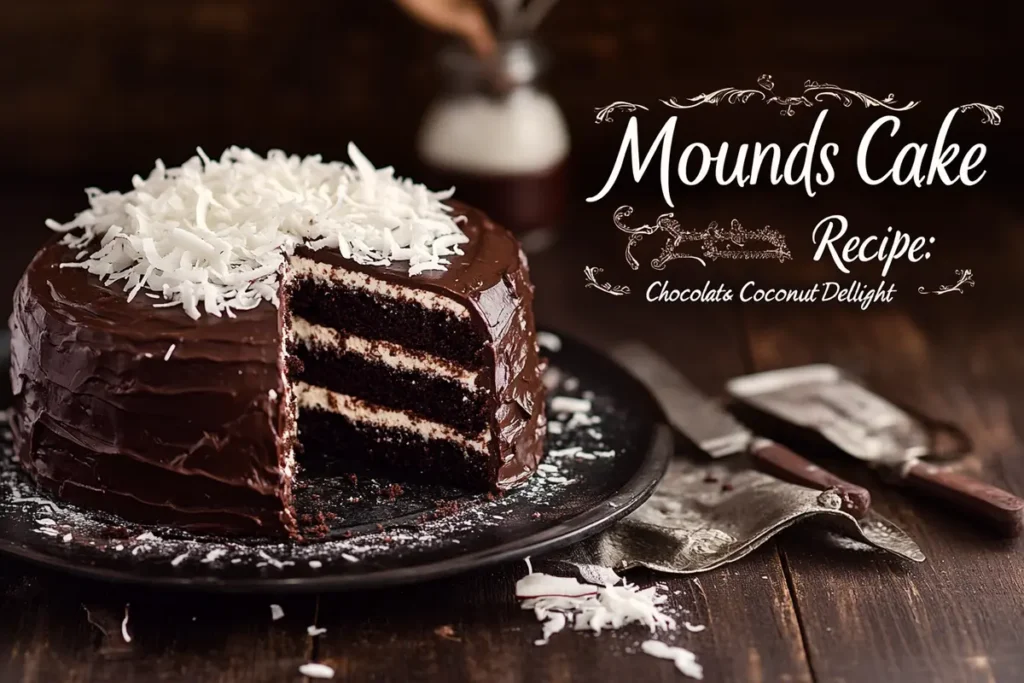
While the mounds cake recipe isn’t known to be overly difficult, every baker encounters stumbling blocks from time to time. Here are some typical mistakes and how you can steer clear of them:
- Overmixing the Batter
Anxious bakers sometimes keep stirring after the dry ingredients go in, which can develop too much gluten. This leads to a tough or dense crumb. Be gentle and switch to a spatula if needed. - Neglecting the Proper Coconut Type
Deciding between sweetened and unsweetened coconut is more than a matter of taste. Sweetened coconut can drastically alter the sugar balance, while unsweetened coconut may not provide enough sweetness to replicate that true “Mounds” candy flavor. Choose wisely based on the recipe. - Using Expired Leavening Agents
Stale baking powder or baking soda is a sure way to get flat cake layers. Always check the expiration date before you start baking, especially if you don’t bake frequently. - Skipping the Cool-Down Period
Patience is key when cooling cake layers. If you try to frost a still-warm cake, the frosting might melt or slide off. This results in a messy presentation. - Underestimating Frosting Needs
Many people run short on frosting because they only factor in the top layer. If you plan to frost the sides and middle layers generously, you may need to double your initial frosting recipe. - Excessively Sweet Results
Adding sweetened condensed milk, sweetened coconut, and a sweet frosting can become cloying. Taste-test your components. If you’re using multiple sugary elements, consider using darker cocoa or a less sweet frosting to balance flavors. - Burnt Coconut Topping
Toasted coconut can go from perfectly golden to burnt in seconds. Keep a close eye on it, stirring often, and remove it from the oven as soon as you see that golden hue. - Forgetting the Flavor Enhancers
Don’t miss out on the chance to elevate your dessert with a splash of coconut extract, a teaspoon of coffee, or a hint of almond flavor. These small additions can set your mounds cake recipe apart from a standard chocolate cake.
By bearing these issues in mind and taking simple precautions, you can significantly boost your chance of nailing the mounds cake recipe on your first—or hundredth—attempt. Baking is part science, part art, and part patience, after all.
Conclusion
There you have it—a comprehensive look at the mounds cake recipe, from its nostalgic candy-bar inspiration to the countless ways you can adapt it for a memorable dessert. By mixing rich chocolate with tender, nutty coconut, you’ll create a winning union of flavors that’s as comforting as it is indulgent. We’ve covered essential ingredients, handy kitchen preparation tips, step-by-step baking instructions, flavor variations, and best practices for storage and topping choices. Along the way, we’ve also pointed out potential pitfalls, ensuring that your baking process proceeds smoothly. Ultimately, with a bit of organization and an adventurous spirit, you can fashion a mounds cake recipe that outshines even the most decadent store-bought sweets. Whether you stay faithful to the timeless version or introduce bold new twists, be prepared for your friends and family to reach for seconds—maybe even thirds. Enjoy every bite!
For more recipes: Irresistible Mounds Cake recipe : A Coconut Chocolate Marvel

